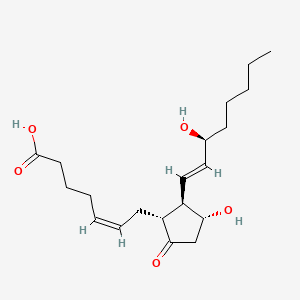| MeSH term | MeSH ID | Detail |
|---|---|---|
| Airway Obstruction | D000402 | 13 associated lipids |
| Uremia | D014511 | 33 associated lipids |
| Colitis, Ulcerative | D003093 | 24 associated lipids |
| Stomach Ulcer | D013276 | 75 associated lipids |
| Kidney Failure, Chronic | D007676 | 51 associated lipids |
| Diarrhea | D003967 | 32 associated lipids |
| Hypoxia | D000860 | 23 associated lipids |
| Hypercalcemia | D006934 | 13 associated lipids |
| Neovascularization, Pathologic | D009389 | 39 associated lipids |
| Adenocarcinoma | D000230 | 166 associated lipids |
Prostaglandin E2
Prostaglandin E2 is a lipid of Fatty Acyls (FA) class. Prostaglandin e2 is associated with abnormalities such as Renal glomerular disease, Arthritis, Degenerative polyarthritis, Pancreatitis and Rheumatoid Arthritis. The involved functions are known as enzyme pathway, Atherogenesis, Anabolism, inhibitors and Oxidants. Prostaglandin e2 often locates in Tissue membrane, Blood, Extracellular, Membrane and Protoplasm. The associated genes with Prostaglandin E2 are PTGS2 gene, TP53 gene, TNFRSF5 gene, FASTK Gene and TNF gene. The related lipids are Lipopolysaccharides, Steroids, monooxyethylene trimethylolpropane tristearate, Fatty Acids, Unsaturated and Promega. The related experimental models are Arthritis, Adjuvant-Induced, Xenograft Model, Experimental Autoimmune Encephalomyelitis, Cancer Model and Knock-out.
Cross Reference
Introduction
To understand associated biological information of Prostaglandin E2, we collected biological information of abnormalities, associated pathways, cellular/molecular locations, biological functions, related genes/proteins, lipids and common seen animal/experimental models with organized paragraphs from literatures.
What diseases are associated with Prostaglandin E2?
Prostaglandin E2 is suspected in Asthma, Inflammatory disorder, Arthritis, Obesity, Renal tubular disorder, Ischemia and other diseases in descending order of the highest number of associated sentences.
Related references are mostly published in these journals:
| Disease | Cross reference | Weighted score | Related literature |
|---|
Possible diseases from mapped MeSH terms on references
We collected disease MeSH terms mapped to the references associated with Prostaglandin E2
PubChem Associated disorders and diseases
What pathways are associated with Prostaglandin E2
There are no associated biomedical information in the current reference collection.
PubChem Biomolecular Interactions and Pathways
Link to PubChem Biomolecular Interactions and PathwaysWhat cellular locations are associated with Prostaglandin E2?
Visualization in cellular structure
Associated locations are in red color. Not associated locations are in black.
Related references are published most in these journals:
| Location | Cross reference | Weighted score | Related literatures |
|---|
What functions are associated with Prostaglandin E2?
Related references are published most in these journals:
| Function | Cross reference | Weighted score | Related literatures |
|---|
What lipids are associated with Prostaglandin E2?
Related references are published most in these journals:
- Prostaglandins Other Lipid Mediat. (5)
- Eur. J. Pharmacol. (3)
- Am. J. Obstet. Gynecol. (3)
- Others (59)
| Lipid concept | Cross reference | Weighted score | Related literatures |
|---|
What genes are associated with Prostaglandin E2?
Related references are published most in these journals:
| Gene | Cross reference | Weighted score | Related literatures |
|---|
What common seen animal models are associated with Prostaglandin E2?
Arthritis, Collagen-Induced
Arthritis, Collagen-Induced are used in the study 'Prostaglandin E2 regulates Th17 cell differentiation and function through cyclic AMP and EP2/EP4 receptor signaling.' (Boniface K et al., 2009), Arthritis, Collagen-Induced are used in the study 'Perspective of microsomal prostaglandin E2 synthase-1 as drug target in inflammation-related disorders.' (Koeberle A and Werz O, 2015), Arthritis, Collagen-Induced are used in the study 'Prostaglandin receptor EP2 in the crosshairs of anti-inflammation, anti-cancer, and neuroprotection.' (Jiang J and Dingledine R, 2013), Arthritis, Collagen-Induced are used in the study 'Comparison of the efficacy and skin permeability of topical NSAID preparations used in Europe.' (Komatsu T and Sakurada T, 2012) and Arthritis, Collagen-Induced are used in the study 'Nitric oxide (NO)-releasing aspirin exhibits a potent esophagoprotection in experimental model of acute reflux esophagitis. Role of nitric oxide and proinflammatory cytokines.' (Pawlik M et al., 2011).
Arthritis, Adjuvant-Induced
Arthritis, Adjuvant-Induced are used in the study 'Comparison of the efficacy and skin permeability of topical NSAID preparations used in Europe.' (Komatsu T and Sakurada T, 2012), Arthritis, Adjuvant-Induced are used in the study 'A pure polysaccharide from Ephedra sinica treating on arthritis and inhibiting cytokines expression.' (Wang Q et al., 2016) and Arthritis, Adjuvant-Induced are used in the study 'Prostaglandin E2 activates Rap1 via EP2/EP4 receptors and cAMP-signaling in rheumatoid synovial fibroblasts: involvement of Epac1 and PKA.' (Kojima F et al., 2009).
Experimental Autoimmune Encephalomyelitis
Experimental Autoimmune Encephalomyelitis are used in the study 'Ginsenoside Rb1 prevents interleukin-1 beta induced inflammation and apoptosis in human articular chondrocytes.' (Cheng W et al., 2013), Experimental Autoimmune Encephalomyelitis are used in the study 'PGE2/EP4 signaling in peripheral immune cells promotes development of experimental autoimmune encephalomyelitis.' (Schiffmann S et al., 2014) and Experimental Autoimmune Encephalomyelitis are used in the study 'Concurrent blockade of free radical and microsomal prostaglandin E synthase-1-mediated PGE2 production improves safety and efficacy in a mouse model of amyotrophic lateral sclerosis.' (Shin JH et al., 2012).
Related references are published most in these journals:
| Model | Cross reference | Weighted score | Related literatures |
|---|
